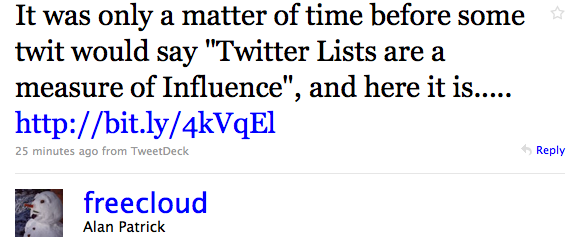Twitter Lists got widely released this past week and people are trying to get their head round what they mean. It’s a slow process categorising people, as there’s no quick way to put people into lists. With a new tool and a slow process, I think it’s going to take a while before user behaviour and list norms get established. It hasn’t stopped people putting their opinions out there though. Chris Brogan has decided he does not like the lists:
Immediately, I realized what I’m not going to like about them: they will exclude people. Sure, on the one hand, they’re a great way to group people and information together. For instance, I might make a list for news feeds. I might make a list about travel, like hotels and airlines. But the minute you move into the people department, things get sketchy quick.
Scoble responds:
Sorry Chris, but life isn’t fair. Steve Gillmor tells me all the time I’m not in control of how people view me. That’s why I don’t feel bad about lists I’m not on. I CAN control my own lists, though, and even when I do my own lists I leave myself off of most of them. That does NOT make me feel bad.
He gives examples of lists that are obviously exclusionary by nature, eg VCs; they’re a fairly objective description of what a person is, so lists like this are self-selecting. The problems that Chris refers are are going to more prevalent when lists are more about what a person is like, when it starts to move towards personal, subjective viewpoints; that’s when feelings are going to get hurt, in the same way that they can be if a person is not followed back. (because unfortunately that’s what people are like).
Another set of posts are about what lists are for – which this one probably falls into. As Alan says on Twitter, there was always bound to be one about how lists are the new measure of influence

On that linked post, Todd Zeigler says
I think Twitter Lists will end up helping separate the men from the boys when it comes to influence. In addition to seeing a Twitter users follower count, we can now see the number of other Twitter users who have added them to lists (example to the right). I would argue that getting added to a list is a bigger deal than simply getting someone to follow you.
And some are already acting on that, with mashable.com basically begging to be added to lists. But as I said earier, I think it’s still too early to determine where lists will go. Being on a list labelled ‘idiots’ or ‘met’ or ‘Bristol’ is not a measure of influence because the lists are being used for a different reason than to categorise expertise in an area.
So I’m going to examine ways in which I think may be used, having taken a look around the developing list frenzy. I think there could 3 main ways that people will categorise things
- To organise the information for themselves. With no thought of others, the lists are there to see sub-sections of the people and entities they follow. From what I’ve seen, this will be the most common use, reflecting the personalised nature of Twitter usage for groups.
- To organise information for others. These will be people who will do the most talking of about the lists, about how good they are, how they will replace the SUL and follow friday. They provide the lists to help others find good stuff (or to demonstrate their influence)
- As a temporary element, around a conference or an event – a list of people attending, a way of pulling all the tweets together.
So how are list users categorising tweeters? Here’s a few methods that I’ve seen so far.
- By their relationship, eg met is a common name at the moment, also buddies, best mates etc
- By their employment, eg company lists, or job type lists, such as Rackspace, or journalists
- By their perceived expertise or role, eg social media, programming
- By their perceived social role, eg connectors, celebs
- By Geography eg London
- By type, eg news, objects, organisational tweets.
- By perceived worth, eg cool, interesting,
- favourite
So how are you using your lists?
2 thoughts on “Twitter Lists”
Comments are closed.